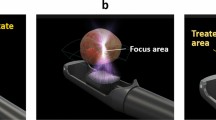Abstract
Objectives
To assess the potential efficacy of the effects of neoadjuvant hormonal therapy on high-intensity focused ultrasound (HIFU) in the treatment of localized prostate cancer.
Methods
One hundred seventy patients with localized prostate cancer underwent HIFU of the prostate, of which 114 patients, who met the study criteria, were included in the current study. The primary outcome was prostate-specific antigen (PSA) changes, and the secondary outcome was morbidity. Biochemical failure was defined according to the Phoenix criteria (prostate-specific antigen nadir +2 ng/ml).
Results
The median follow-up period for all patients was 45.0 months (range: 12–70). All patients underwent PSA evaluation, and 52 (56.5%) had a 2-month PSA nadir recorded at the follow-up visit. PSA nadir was achieved by 3 months in 84.2% of treatments. The mean PSA nadir was 0.28 ng/ml. The 114 patients consisted of two groups: 44 patients treated with neoadjuvant hormonal therapy (group 1), and 70 patients treated without neoadjuvant hormonal therapy (group 2). The mean PSA nadir achieved in group 1 was 0.19 ng/ml versus 0.34 ng/ml in group 2 (n.s.). The occurrence rates of treatment-related toxicities were similar in both groups.
Conclusion
In patients with localized prostate cancer, HIFU therapy resulted in comparable immediate cancer control. The present results indicate that combined treatment using hormonal therapy and HIFU does not have a synergistic effect on the PSA nadir.


Similar content being viewed by others
References
D’Amico AV, Whittington R, Malkowicz SB, Schultz D, Blank K, Broderick GA, Tomaszewski JE, Renshaw AA, Kaplan I, Beard CJ, Wein A (1998) Biochemical outcome after radical prostatectomy, external beam radiation therapy, or interstitial radiation therapy for clinically localized prostate cancer. JAMA 280(11):969–974
Roach M 3rd, Hanks G, Thames H Jr, Schellhammer P, Shipley WU, Sokol GH, Sandler H (2006) Defining biochemical failure following radiotherapy with or without hormonal therapy in men with clinically localized prostate cancer: recommendations of the rtog-astro phoenix consensus conference. Int J Radiat Oncol Biol Phys 65(4):965–974. doi:10.1016/j.ijrobp.2006.04.029
Cooperberg MR, Grossfeld GD, Lubeck DP, Carroll PR (2003) National practice patterns and time trends in androgen ablation for localized prostate cancer. J Natl Cancer Inst 95(13):981–989
Potosky AL, Harlan LC, Stanford JL, Gilliland FD, Hamilton AS, Albertsen PC, Eley JW, Liff JM, Deapen D, Stephenson RA, Legler J, Ferrans CE, Talcott JA, Litwin MS (1999) Prostate cancer practice patterns and quality of life: the prostate cancer outcomes study. J Natl Cancer Inst 91(20):1719–1724
Messing EM, Manola J, Sarosdy M, Wilding G, Crawford ED, Trump D (1999) Immediate hormonal therapy compared with observation after radical prostatectomy and pelvic lymphadenectomy in men with node-positive prostate cancer. N Engl J Med 341(24):1781–1788
Aus G, Abrahamsson PA, Ahlgren G, Hugosson J, Lundberg S, Schain M, Schelin S, Pedersen K (2002) Three-month neoadjuvant hormonal therapy before radical prostatectomy: a 7-year follow-up of a randomized controlled trial. BJU Int 90(6):561–566
Shahinian VB, Kuo YF, Freeman JL, Goodwin JS (2005) Risk of fracture after androgen deprivation for prostate cancer. N Engl J Med 352(2):154–164. doi:10.1056/NEJMoa041943
Keating NL, O’Malley AJ, Freedland SJ, Smith MR (2010) Diabetes and cardiovascular disease during androgen deprivation therapy: observational study of veterans with prostate cancer. J Natl Cancer Inst 102(1):39–46. doi:10.1093/jnci/djp404
Isbarn H, Boccon-Gibod L, Carroll PR, Montorsi F, Schulman C, Smith MR, Sternberg CN, Studer UE (2009) Androgen deprivation therapy for the treatment of prostate cancer: consider both benefits and risks. Eur Urol 55(1):62–75. doi:10.1016/j.eururo.2008.10.008
Efstathiou JA, Bae K, Shipley WU, Hanks GE, Pilepich MV, Sandler HM, Smith MR (2009) Cardiovascular mortality after androgen deprivation therapy for locally advanced prostate cancer: Rtog 85–31. J Clin Oncol 27(1):92–99. doi:10.1200/JCO.2007.12.3752
Blana A, Murat FJ, Walter B, Thuroff S, Wieland WF, Chaussy C, Gelet A (2008) First analysis of the long-term results with transrectal hifu in patients with localised prostate cancer. Eur Urol 53(6):1194–1201. doi:10.1016/j.eururo.2007.10.062
Ganzer R, Rogenhofer S, Walter B, Lunz JC, Schostak M, Wieland WF, Blana A (2008) Psa nadir is a significant predictor of treatment failure after high-intensity focussed ultrasound (hifu) treatment of localised prostate cancer. Eur Urol 53(3):547–553. doi:10.1016/j.eururo.2007.07.010
Uchida T, Ohkusa H, Nagata Y, Hyodo T, Satoh T, Irie A (2006) Treatment of localized prostate cancer using high-intensity focused ultrasound. BJU Int 97(1):56–61. doi:10.1111/j.1464-410X.2006.05864.x
Blana A, Rogenhofer S, Ganzer R, Wild PJ, Wieland WF, Walter B (2006) Morbidity associated with repeated transrectal high-intensity focused ultrasound treatment of localized prostate cancer. World J Urol 24(5):585–590. doi:10.1007/s00345-006-0107-x
Chaussy C, Thuroff S (2003) The status of high-intensity focused ultrasound in the treatment of localized prostate cancer and the impact of a combined resection. Curr Urol Rep 4(3):248–252
Poissonnier L, Chapelon JY, Rouviere O, Curiel L, Bouvier R, Martin X, Dubernard JM, Gelet A (2007) Control of prostate cancer by transrectal hifu in 227 patients. Eur Urol 51(2):381–387. doi:10.1016/j.eururo.2006.04.012
Ahmed HU, Zacharakis E, Dudderidge T, Armitage JN, Scott R, Calleary J, Illing R, Kirkham A, Freeman A, Ogden C, Allen C, Emberton M (2009) High-intensity-focused ultrasound in the treatment of primary prostate cancer: the first uk series. Br J Cancer 101(1):19–26. doi:10.1038/sj.bjc.6605116
Shoji S, Nakano M, Nagata Y, Usui Y, Terachi T, Uchida T (2010) Quality of life following high-intensity focused ultrasound for the treatment of localized prostate cancer: a prospective study. Int J Urol 17(8):715–719. doi:10.1111/j.1442-2042.2010.02568.x
Conflict of interest
The authors declare that they have no conflicts of interest.
Author information
Authors and Affiliations
Corresponding author
Additional information
Yutaka Fujisue, Haruhito Azuma, and Teruo Inamoto equally attributed to the work.
Rights and permissions
About this article
Cite this article
Fujisue, Y., Azuma, H., Inamoto, T. et al. Neoadjuvant hormonal therapy does not impact the treatment success of high-intensity focused ultrasound for the treatment of localized prostate cancer. World J Urol 29, 689–694 (2011). https://doi.org/10.1007/s00345-010-0628-1
Received:
Accepted:
Published:
Issue Date:
DOI: https://doi.org/10.1007/s00345-010-0628-1




